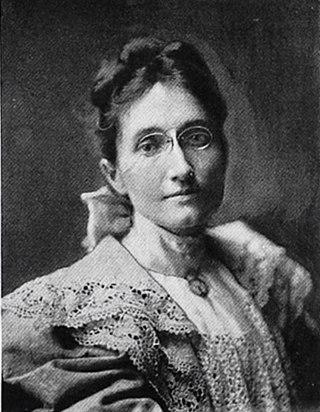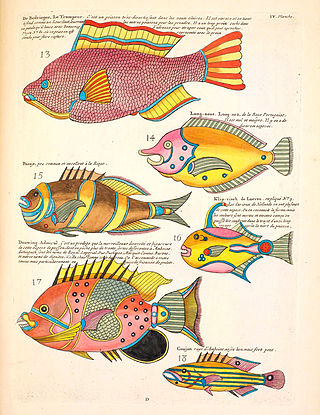
Stationery refers to writing materials, including cut paper, envelopes, writing implements, continuous form paper, and other office supplies. Stationery includes materials to be written on by hand or by equipment such as computer printers.

Thomas Moran was an American painter and printmaker of the Hudson River School in New York whose work often featured the Rocky Mountains. Moran and his family, wife Mary Nimmo Moran and daughter Ruth, took residence in New York where he obtained work as an artist. He was a younger brother of the noted marine artist Edward Moran, with whom he shared a studio. A talented illustrator and exquisite colorist, Thomas Moran was hired as an illustrator at Scribner's Monthly. During the late 1860s, he was appointed the chief illustrator for the magazine, a position that helped him launch his career as one of the premier painters of the American landscape, in particular, the American West.

Trapper Keeper is a brand of loose-leaf binder created by Mead. Popular with students in the United States and parts of Latin America from the 1970s to the 1990s, it featured sliding plastic rings, folders, and pockets to keep schoolwork and papers, and a wrap-around flap with a Velcro closure.

A manila folder is a file folder designed to contain documents, often within a filing cabinet. It is generally formed by folding a large sheet of stiff card in half. Though traditionally buff, sometimes other colors are used to differentiate categories of files.

Pentel Co., Ltd. is a privately-held Japanese manufacturing company of stationery products. The name comes from one of their first widely known products and is a portmanteau of the English words pen and pastel. Pentel is also the inventor of non-permanent marker technology. Most Pentel products are manufactured in Japan, Taiwan, Korea, Mexico, and France.

The O-Pee-Chee Company, Ltd. was a Canadian confectionery company founded in 1911 based in London, Ontario. O-Pee-Chee was best known as a maker of trading cards. It entered into a marketing agreement with the Topps Company in 1958, releasing several collections of baseball, gridiron football and ice hockey cards.

Alma Woodsey Thomas was an African-American artist and teacher who lived and worked in Washington, D.C., and is now recognized as a major American painter of the 20th century. Thomas is best known for the "exuberant", colorful, abstract paintings that she created after her retirement from a 35-year career teaching art at Washington's Shaw Junior High School.

Jessie Willcox Smith was an American illustrator during the Golden Age of American illustration. She was considered "one of the greatest pure illustrators". A contributor to books and magazines during the late 19th and early 20th centuries, Smith illustrated stories and articles for clients such as Century, Collier's, Leslie's Weekly, Harper's, McClure's, Scribners, and the Ladies' Home Journal. She had an ongoing relationship with Good Housekeeping, which included a long-running Mother Goose series of illustrations and also the creation of all of the Good Housekeeping covers from December 1917 to 1933. Among the more than 60 books that Smith illustrated were Louisa May Alcott's Little Women and An Old-Fashioned Girl, Henry Wadsworth Longfellow's Evangeline, and Robert Louis Stevenson's A Child's Garden of Verses.

Frank Henry Netter was an American surgeon and medical illustrator. The first edition of his Atlas of Human Anatomy — his "personal Sistine Chapel" — was published in 1989; he was a fellow of the New York Academy of Medicine where he was first published in 1957.
The Torii school was a school of ukiyo-e painting and printing founded in Edo. The primary producers of kabuki theater signboards and other promotional materials, the Torii were among those whose work led to the development of ukiyo-e. Their style was one of the primary influences in the ukiyo-e depiction of actors and kabuki scenes for much of the 18th century. Still today, kabuki signboards are sometimes painted by members of the Torii family.

Elenore Plaisted Abbott (1875–1935) was an American book illustrator, scenic designer, and painter. She illustrated early 20th-century editions of Grimm's Fairy Tales,Robinson Crusoe, and Kidnapped. Several books were published as illustrated by Elenore Plaisted Abbott and Helen Alden Knipe.

Prentiss Taylor was an American illustrator, lithographer, and painter. Born in Washington D.C., Taylor began his art studies at the Corcoran Gallery of Art, followed by painting classes under Charles Hawthorne in Provincetown, Massachusetts, and training at the Art Students League in New York City. In 1931, Taylor began studying lithography at the League. He became a member of one of the most important printmaking societies in America at that time, the Society of American Graphic Artists. Taylor interacted and collaborated with many writers and musicians in his time in New York in the late 1920s and early 30s. This was in the emergence of the Harlem Renaissance. Among his close friends and colleagues were Langston Hughes and Carl Van Vechten.

Alice Barber Stephens was an American painter and engraver, best remembered for her illustrations. Her work regularly appeared in magazines such as Scribner's Monthly, Harper's Weekly, and The Ladies Home Journal.

Jennie Augusta Brownscombe was an American painter, designer, etcher, commercial artist, and illustrator. Brownscombe studied art for years in the United States and in Paris. She was a founding member, student and teacher at the Art Students League of New York. She made genre paintings, including revolutionary and colonial American history, most notably The First Thanksgiving held at Pilgrim Hall in Plymouth, Massachusetts. She sold the reproduction rights to more than 100 paintings, and images of her work have appeared on prints, calendars and greeting cards. Her works are in many public collections and museums. In 1899 she was described by New York World as "one of America's best artists."

Biological illustration is the use of technical illustration to visually communicate the structure and specific details of biological subjects of study. This can be used to demonstrate anatomy, explain biological functions or interactions, direct surgical procedures, distinguish species, and other applications. The scope of biological illustration can range from the whole organism level to microscopic.
Alice R. Tangerini is an American botanical illustrator. In 1972, Tangerini was hired as a staff illustrator for the Department of Botany at the National Museum of Natural History by American botanist Lyman Bradford Smith. Prior to working at the Smithsonian Institution, she received a Bachelor of Fine Arts from Virginia Commonwealth University. As of March 9, 2017, Tangerini remains the only botanical illustrator ever hired by the Smithsonian.

The Black Lives Matter movement has been depicted and documented in various artistic forms and mediums including film, song, television, and the visual arts. In some instances this has taken place in the form of protest art. These cultural representations have also grown organically among artists who seek to partake in activist efforts in support or in recognition of the Black Lives Matter movement. The themes conveyed in these artistic works address the history of racism and injustice toward people of color in the United States and typically express sentiments of anger and fear as well as solace and hope.
Patrick Martinez is a visual artist based in Los Angeles. He works in mixed-media landscape paintings, neon sign artwork, as well as his Pee Chee collection of works. One of his signature styles of art is depicting and memorializing victims of abuse as the subjects of his art.
















